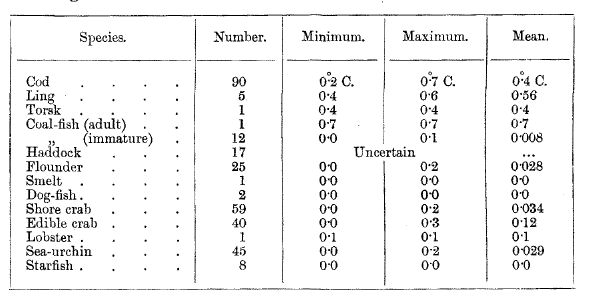Article contents
VI.—The Body-Temperature of Fishes and other Marine Animals.
Published online by Cambridge University Press: 15 September 2014
Summary
The body-temperature of the following fishes, crustaceans, and echinoderms has been examined and compared with the temperature of the water in which they live:—Cod-fish (Gadus morrhua), ling (Molva vulgaris), torsk (Brosmius brosme), coal-fish or saithe (Gadus virens), haddock (Gadus œgelfinus), flounder (Pleuronectes flesus), smelt (Osmerus eperlanus), dog-fish (Scyllium catulus), shore crab (Carcinus mœnas), edible crab (Cancer pagurus), lobster (Homarus vulgaris), sea-urchin (Echinus esculentus), and starfish (Asterias rubens). The minimum, maximum, and mean temperature difference for each species are given in the following table:—
The excess of temperature is most evident in the larger specimens. This is well shown in the case of the coal-fish, where in the adult it was 0°·7 C., and in the great majority (11 out of 12) of the young of the first year, 0°·0 C. The body-weight and the conditions under which the fish are captured probably form the most important factors in determining the temperature difference.
In 14 codfish, where the rectal, blood, and muscle temperatures were recorded in the same individual, it was found to be highest in the muscle and lowest in the rectum, the mean temperature difference being 0°·46 C. for the muscle, 0°·41 C for the blood, and 0°·36 C. for the rectum.
- Type
- Proceedings
- Information
- Copyright
- Copyright © Royal Society of Edinburgh 1908
References
page 66 note * Richet, Dict. de Physiol., vol. iii., p. 108.
page 66 note † Hunter, , Complete Works (London, 1837), vol. iii., p. 16.Google Scholar
page 66 note ‡ Bergmann, , Göttingen Studien, 1847, Abth. i., S. 595.Google Scholar
page 67 note * Sutherland, , Roy. Soc. Victoria Proc., 1896, vol. ix., new series.Google Scholar
page 67 note † Macleay, , Linn. Soc. N.S. Wales Proc., vol. ix., 1st series, p. 1204.Google Scholar
page 67 note ‡ Martin, Phil. Trans. Roy. Soc, B., vol. cxcv., pp. 1–37.
page 67 note § Vernon, , Science Progress, vol. vii., 1898, p. 378.Google Scholar
page 74 note * Richet, Dict. de Physiol., vol. iii., p. 106.
page 81 note * Gavarret, , Physique Médicale, Massem, Paris, 1855, pp. 125–141.Google Scholar
page 81 note † It is difficult to believe that the body of a fish can have a lower temperature than the water which surrounds it, if the temperature of the water is stationary and not slowly rising.
- 6
- Cited by




